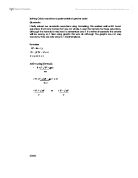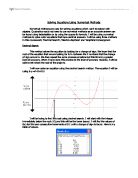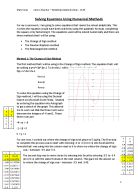Now, I have decided to go and look for other ways in which it would be possible to find all the factors of the equations which is accurate.
I have now found a new method which helps to find roots of equations this is called the change of sign method, I am now going to research this method and then try the method on some equations.
X³ - 4x² + x + 6 = 0
F ‘ (x) = x³ - 4x² + x + 6 = 0
F ‘ (x) = 1³ - 4(1)² + 1 + 6 ≠ 0
F ‘ (x) = -1³ - 4(-1)² - 1 + 6 = 0
… (x + 1) is a factor
x² - 5x + 6
x + 1 √ x³ - 4x² + x + 6
- x³ + x²
- 5x² + x
- - 5x² - 5x
6x + 6
- 6x + 6
(x + 1) (x² - 5x + 6)
(x + 1) (x – 3) (x – 2)
Change of Sign
There are three types:-
- Interval Estimation which includes
- Decimal Search
- Interval Bisection
- Linear Interpolation
I have decided to use decimal search.
In order to use this method I must find an approximate root. I have already drawn the graph and so I can see that there is a root that lies between 1 and 2.
From my graph I know the root is 2.8 correct to one decimal place. With decimal search to find a more accurate value for the root I must look for a change of sign to locate the root. With decimal search after each iteration I divide the interval into 10 equal parts.
- Step 1 – Once a root is found, you use increments of firstly 0.1 working out the value for the function. You do this until a change of sign is found.
- Step 2 – There is a change of sign, therefore there is a root. Having narrowed down the interval, you continue with increments of 0.001. looking for a change of sign.
- Step 3 – This process is continued to find a more accurate root, which is usually a value correct to 5 decimal places.
Whilst using the change of sign method to locate accurate values for roots I came across some equations where there is a root but the change of sign method does not show the root, this is because there is no change of sign. I feel this method is not reliable enough as it does not find all roots. I am now going to research other methods of finding roots.
Fixed point iteration
In fixed point iteration you find a single value as your estimate for the x value. This involves an interactive process a method of generating a sequence of numbers by continued repetition of the same procedure. If the numbers obtained in this manner approach some limiting value, they are said to converge to this value.
-
Step 1 – With the chosen equation, you must rearrange it in the form x = g ’ (x). This provides the basis for the iterative formula.
-
Step 2 – Choose a start value for x.
-
Step 3 – Find the corresponding value of g ‘ (x).
-
Step 4 – Take this value as the new x value, and find the new g(x) value.
- Step 5 – This is continued until the x value and the g ‘ (x) value are equal. When this occurs the equation has converged.
The successive steps look like a staircase approaching the root. Other equations may produce a cobweb diagram; here x values oscillate about the root.
If the equation is arranged in some ways the equation will not converge as x = g ‘ (x) will only converge to a root if -1 < g ‘ (x) < 1 for values of x close to the root.
Newton Raphson
Another fixed point estimation method, and as with the previous method it is necessary to use an estimate of the root as a starting point.
-
Step 1 - You start with an estimate, x1, for a root of f ’ (x) = 0.
-
Step 2 – You then draw a tangent to the curve Y = f ‘ (x) at the point (x1, f ‘ (x)).
-
Step 3 – The point at which the tangent cuts the x axis then gives the next approximation for the root.
- Step 4 – This process is then repeated until the values converge.
I have come across a few problems with this method also as if a poor starting value is chosen, the iteration may diverge. Or the tangent may meet the axis at a point outside the domain of the function. If this happens you will not locate the root, even if it is there.







